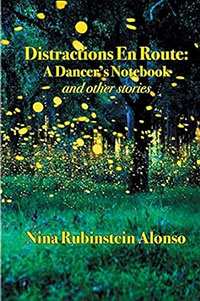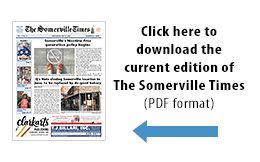 *
*
Review by Off the Shelf Correspondent Lee Varon
Nina Rubinstein Alonso’s story collection Distractions En Route: A Dancer’s Notebook and Other Stories is a marvelous collage of thirty vivid stories.
The opening two stories keenly portray a dancer’s life, as in the opening story, The Redhead Number 37, which begins with the line: “Sixty girls lined up can’t see how they look because the mirrors are draped in paper.” One by one, these dancers are eliminated. The way in which women’s bodies are objectified is heightened in the world of dance. We are told “Eliminations start with ‘body cuts’ noted on our file cards – torso long, hips wide, head large, feet stiff.”
It is painful to learn how heartless and capricious this culling process can be. “We’re trained to accept defeat with grace, maintain discipline, no bitching, no whining.” Those in charge of making these decisions are depicted by Alonso with trenchant accuracy. There’s Marina, drinking coffee and eating a wedge of pastry, and David, a Brit from the Royal Ballet who “pounds his cane, chain smokes … kicks people out who annoy him.” When he decides to close the dance studio he leaves with a flourish: “With parting rage he takes his cane and bashes studio mirrors, one sharp crack each, so they’ll be useless to anyone else.”

Distractions En Route: A Dancer’s Notebook and Other Stories by Nina Rubinstein Alonso(available at Ibbetson Street Press and on Amazon)
Although wonderfully drawn tales from ballet open ˆ, this is by no means a collection that primarily centers on dance. It is more about life itself; particularly male/female relationships. In addition, there is a golden thread of spiritual seeking that is woven throughout many of these stories as the protagonists seek wholeness and meaning in their lives amid their sometimes chaotic and tumultuous existence.
This juxtaposition of everyday life and spiritual connection also reminds me of the cover of Distractions – pinpoints of golden light on a background of a blurred and tangled forest. This spiritual seeking often takes the form of journeys to India where Alonso, with a few deft brush strokes, brings the reader into the world of meditation centers and ashrams. This spiritual journey was, for me, the heart of Distractions, and yet overlaying this spiritual quest is a scintillating array of stories about relationships.
These stories are not told chronologically. A story about an early marriage may appear early in the book and then again near the end. This technique mirrors the way in which our minds often wander in and out of past and present.
Alonso is a well-established poet and this comes through in her stories. The wonderful attention to detail as, for example, in her depiction of a newlywed couple (Leah and Sam) sailing on the Chesapeake: “…watching Sam adjust the spinnaker while she tosses peanut shells overboard. They had nothing to say to each other, their silence not about the beauty of the waves, but about emotional numbness.” I felt like I was watching the beginning of a movie with growing trepidation.
The denouement to this ill-fated marriage finally arrives in the story Fog – a gripping vignette rich with metaphor. Sam – arrogant and foolhardy – has insisted on a sailing trip despite oncoming fog. The couple sets out in their small sailboat with no auxiliary motor. As the sails are “luffing and flapping in the erratic wind” Sam himself remains unflappable as Leah fumes and regrets not only this voyage but the marriage, and reminisces, ruefully, about a former boyfriend whom she had dumped to marry Sam. The growing fog which turns out to be the worst in a century is an obvious metaphor for the growing muddle of their relationship.
Despite this bleakness, Alonso is gifted at finding the humorous in awkward situations. Recalling her first encounter with Sam’s upper-class family – Leah, from a middle-class Jewish family – sits down for dinner, fiddling with her napkin, “watching Sam to be sure which of the many forks to select for the first course.” The meal unfolds as Alonso writes with exquisite detail: “Matzo balls bounce in the chicken broth and Leah cautiously pushes her spoon into the spongy stuff hoping one won’t jump out of her bowl onto the gray linen tablecloth.” And listening to the dinner banter: “Their words sift through her mind like salt, irritating, disconnected grains.” Other relationships and a second marriage which ends in divorce, are recounted in other stories – “…a series of dismal men” which includes Josh and Hank referred to as “dullsville duo, shaggy, unappealing computer-geeks” then Kent “ginger-haired, hyper-chatty about nothing much.” Also, along the way are deep connections – one with a man who passes away from lung cancer.
The book is replete with memorable images and phrases. Just to name a few of my favorites:
After the loss of a loved one: “The past is a pain museum whose doors never close.”
“The campus is a rippling anxiety caterpillar.”
On a trip to India with her lover: “Why obsess about the future, the ultimate lock box with no password? At the table, I pick up my chopsticks, try to focus on ‘now.’”
And towards the end of the book: “Shifting directions is like a big ship turning, dealing with forces of wind and water, requiring massive energy to redirect. But it’s the self, heart-center, trying to choose without making another blunder. If we were filming there’d be a close shot of my hands gripping the rail.”
The author seems far from distracted as she keenly observes the world around her and brings her cast of characters alive with realistic often edgy dialogue that sometimes reminded me of the quick repartee of a great film noir. I fell in love with many of the characters in this collection and recoiled at the crassness, narcissism, or pettiness of others. It is interesting that this book of thirty stories ends with the phrase… “no words feel big enough.” I was left with the feeling that no words were big enough to capture the depth and expanse of the stories in this moving collection.















Reader Comments